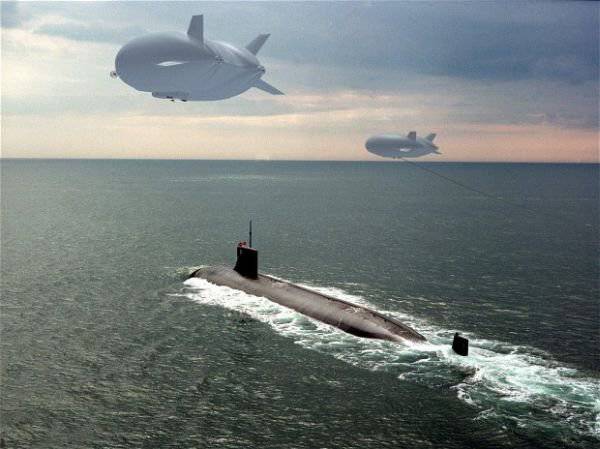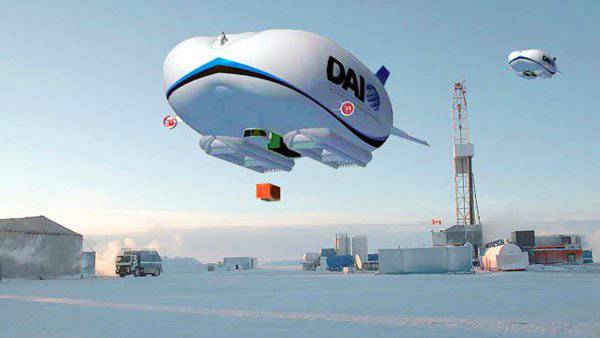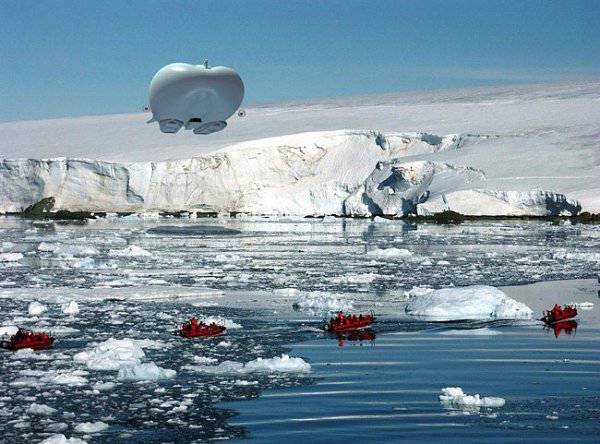Big airships can appear in the sky again.

A whole group of multi-purpose airships developed by a small British company Hybrid Air Vehicles (HAV). One of the types of apparatus may soon be put into operation by the American army. The tests are conducted by Americans under the control of Northrop Grumman.
Why precisely “hybrid” airships? Such apparatuses are distinguished by small wings, creating a lifting force that compensates up to 40% of the weight of the airship itself. In other words, unlike the Zeppelin, it does not take off on its own. And this means that they lack some disadvantages, but with the pluses, everything is in order. They are much easier to keep on the ground: if the motors are turned off, then they “do not tear” into the sky. Having a smaller weight compensation, they are not so much demolished side wind. A hybrid airship requires less ballast, and it is almost not affected by the production of fuel. While the classic airship, having lost five to ten percent of its mass, is forced to release expensive gas into the atmosphere when it returns to the ground, the hybrid airship simply turns off the engines, the lift force from the wings disappears, the aircraft smoothly descends.
There is a British device and a highlight: as in the "Thermoplane" of Soviet production, the body, having an elliptical shape, is itself something of a wing, having a particularly thick profile. It is this feature allows you to raise the weight compensation from the lifting force to forty percent (for conventional hybrid cars - up to twenty percent). Thus, the disadvantages arise from the merits: the "hybrid" is not able to hang permanently; if all 4 engines fail, you will have to land. However, it is worth noting that even when operating one motor, it will stay in the air, which cannot be said about a single four-engined aircraft. Like all hybrid airships, Hybrid Air Vehicles (HAV) requires a runway platform, but relatively short and requiring no special training. For this you can use the field, any water surface and so on.

The intelligence of the US military, having a shell volume in 304 38 m³ and a ceiling in 000 6 m, is able to patrol in a given area for 000 of the day with only one refueling station. The length of the device is 21 meters, width - 91 meters, height - 34 meters. Despite the fact that its cruising speed is 26 km / h, the speed at which reconnaissance is supposed to be equal is just 150 km / h. At this rate, HAV 37 without refueling gets to almost anywhere in the world. The car has four 304-strong diesel four-liter eight-cylinder engines, providing low fuel consumption at "economic" speed. The airship is equipped with an original chassis system consisting of two inflatable cylinders located along the side edges of the device, which are huge floats that allow you to sit on the water. In this case, the double-shell hull performs the function of a catamaran, which significantly reduces the risk of tipping over. During the flight, balloon floats are drawn into the hull to reduce aerodynamic drag.
The management of a hundred-meter-wide hulk takes place with the help of one pilot, and it is an option rather than a necessity: the airship feels fine under the supervision of a remote operator or on-board computer.
The semi-rigid design of the HAV 304 (as in the combat airships of the First World War) has many compartments that are filled with helium. If the non-flammable shell is shot through by a bullet or a rocket, then its damage will be minor: a modern rocket is not capable of disabling such a large apparatus. Even with a massive bombardment, the airship will only go on a slow decline. It will not sink into the sea: they will not allow compartments with helium to sink.
It is assumed that such a machine will cost 60 million pounds.
The British company from Bedford has other projects that have interested the US military: cargo types of airships designed by developers. They can easily be transported by air to 150 troops with a light weapons and even with inflatable boats. These airships can be effectively used to combat pirate ships. When launched, the airships are very stable and at the same time much less energy consuming than, for example, hovercraft.
According to reports, back in 2010, HAV received an order from the Pentagon for the 4 airship of the type described for a total of 315 million pounds. It was reported that these aircraft will be used in Afghanistan.
Despite this, the British themselves are still not reliably able to explain the real principles of the designation of airships produced. HAV304’s descriptions are deliberately inaccurate, indicating that the UK is unwilling to disclose the full range of information about its developments.

Information